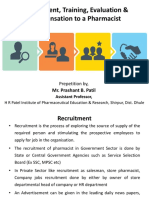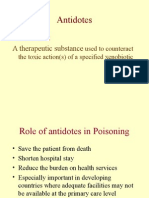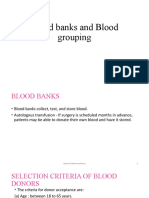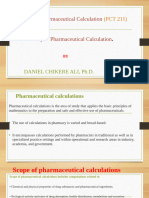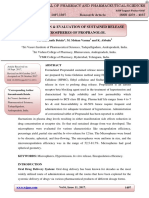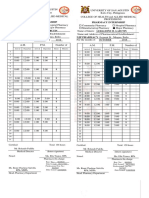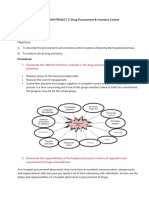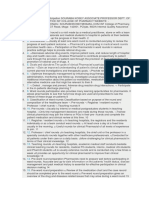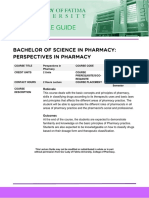0 ratings0% found this document useful (0 votes)
552 viewsChapter 4. Drug Distribution System
Chapter 4. Drug Distribution System
Uploaded by
manthanpednekar743This document discusses different methods for drug distribution within hospitals. It describes inpatient and outpatient distribution. For inpatients, methods discussed include unit-dose dispensing where each patient receives individually packaged doses, ward stock where medication is stored on the patient's ward, and automated dispensing cabinets. For outpatients, distribution can occur through retail pharmacies, specialty pharmacies, and mail-order pharmacies. The document also provides details on the individual prescription order method and complete floor stock system for inpatient distribution, including their advantages and disadvantages.
Copyright:
© All Rights Reserved
Available Formats
Download as PDF, TXT or read online from Scribd
Chapter 4. Drug Distribution System
Chapter 4. Drug Distribution System
Uploaded by
manthanpednekar7430 ratings0% found this document useful (0 votes)
552 views65 pagesThis document discusses different methods for drug distribution within hospitals. It describes inpatient and outpatient distribution. For inpatients, methods discussed include unit-dose dispensing where each patient receives individually packaged doses, ward stock where medication is stored on the patient's ward, and automated dispensing cabinets. For outpatients, distribution can occur through retail pharmacies, specialty pharmacies, and mail-order pharmacies. The document also provides details on the individual prescription order method and complete floor stock system for inpatient distribution, including their advantages and disadvantages.
Copyright
© © All Rights Reserved
Available Formats
PDF, TXT or read online from Scribd
Share this document
Did you find this document useful?
Is this content inappropriate?
This document discusses different methods for drug distribution within hospitals. It describes inpatient and outpatient distribution. For inpatients, methods discussed include unit-dose dispensing where each patient receives individually packaged doses, ward stock where medication is stored on the patient's ward, and automated dispensing cabinets. For outpatients, distribution can occur through retail pharmacies, specialty pharmacies, and mail-order pharmacies. The document also provides details on the individual prescription order method and complete floor stock system for inpatient distribution, including their advantages and disadvantages.
Copyright:
© All Rights Reserved
Available Formats
Download as PDF, TXT or read online from Scribd
Download as pdf or txt
0 ratings0% found this document useful (0 votes)
552 views65 pagesChapter 4. Drug Distribution System
Chapter 4. Drug Distribution System
Uploaded by
manthanpednekar743This document discusses different methods for drug distribution within hospitals. It describes inpatient and outpatient distribution. For inpatients, methods discussed include unit-dose dispensing where each patient receives individually packaged doses, ward stock where medication is stored on the patient's ward, and automated dispensing cabinets. For outpatients, distribution can occur through retail pharmacies, specialty pharmacies, and mail-order pharmacies. The document also provides details on the individual prescription order method and complete floor stock system for inpatient distribution, including their advantages and disadvantages.
Copyright:
© All Rights Reserved
Available Formats
Download as PDF, TXT or read online from Scribd
Download as pdf or txt
You are on page 1of 65
Drug Distribution System
• Drug distribution (in- patients and out - patients) –
Definition, advantages and disadvantages of
individual prescription order method, Floor Stock
Method, Unit Dose Drug Distribution Method, Drug
Basket Method.
• Distribution of drugs to ICCU/ICU/NICU/Emergency
wards.
• Automated drug dispensing systems and devices
• Distribution of Narcotic and Psychotropic substances
and their storage
• Drug distribution : Drug distribution is defined as,
“Physical transfer of drugs from storage area in the
hospital to the patient’s bedside”.
• This involves two types of drug distribution. They are:
1. In-patient distribution
2. Out-patient distribution
Inpatient: The patients who occupy the bed in hospital for
diagnosis and treatment
Out patient : Patients who does not occupy bed in hospital
General outpatient: Patient is given service for preventive
healthcare, diagnosis and treatment after confirming general
discomfort, complaints, symptoms, and which is not
emergency case
• Referred out patient: Patient who is directly referred
to out-patient department of hospital by a general
practitioner and PHC for specific treatment.
➢ Inpatient distribution:
• The drug distribution to the in-patient department can be
carried out from the Out-patient dispensing area.
• The pharmacists involved in dispensing the drugs for Out-
patient can dispense drugs for in patients too.
• The pharmacist employed for drug distribution to the In-
patient wards should be well skilled and qualified staff.
• This can be done through a number of different methods,
including:
1. Unit-dose dispensing: This involves providing each
patient with individually packaged doses of medication,
which are labeled with the patient's name and the
medication's name and dosage. This helps to prevent
medication errors and ensures that patients receive the
correct medication at the correct time.
2. Ward stock: This involves storing medication on the
patient's ward, rather than in a central pharmacy. Nurses or
other healthcare professionals can then access the
medication as needed.
3. Automated dispensing cabinets: These are computerized
cabinets that store medication and dispense it automatically
when authorized healthcare professionals enter their
credentials
➢Out-patient drug distribution:
• Out-patient drug distribution involves providing medication
to patients who are not currently admitted to a healthcare
facility.
• This can include patients who are receiving treatment at a
clinic, doctor's office, or other outpatient facility, as well as
patients who are managing their own medication at home.
Out-patient drug distribution methods can include:
1. Retail pharmacies: Patients can obtain their medication
from a retail pharmacy, either in-person or through mail
order.
2. Specialty pharmacies: These pharmacies specialize in
providing medication for patients with complex medical
conditions, such as cancer or HIV.
3. Mail-order pharmacies: Patients can order their
medication online or over the phone and have it
delivered to their home.
❖ Individual prescription order method
• Individual prescription order system: It is a type of
prescription system where the physician writes the
prescription for individual patient who obtains the drug
prescribed from any medical store or hospital dispensary by
paying own charges, It is mainly used in small hospitals.
• The individual prescription order method is a drug
distribution method that involves providing each patient
with individually packaged doses of medication, which are
labeled with the patient's name and the medication's name
and dosage. Here are some advantages of this method:
➢ Advantages of individual prescription order method:
1. Reduces medication errors:
• With individual prescription order method, the chances of
medication errors are significantly reduced since the
medication is packaged and labeled specifically for the
individual patient.
• This helps to ensure that patients receive the correct
medication at the correct time, which can improve patient
safety and outcomes.
2. Convenient for patients: Individual prescription order
method is convenient for patients as they do not have to
worry about remembering to take multiple pills at
different times throughout the day. The medication is
packaged in a way that is easy to take and can be taken
on-the-go.
3. Helps with medication adherence: This method can
improve medication adherence as patients are more likely
to take their medication as prescribed when it is packaged
and labeled specifically for them. This can help to
improve health outcomes and reduce hospitalizations and
readmissions.
4. Reduces waste: With individual prescription order
method, there is less medication waste since the
medication is dispensed in the exact amount needed for
each patient. This can help to reduce the overall cost of
medication and minimize the impact on the environment
➢ Disadvantages of individual prescription order
method
1. Cost: This method can be more expensive than other
methods of drug distribution, such as ward stock or unit-
dose dispensing. The packaging and labeling process for
each individual dose can be time-consuming and costly.
2. Time-consuming: The process of packaging and labeling
each individual dose can be time consuming for healthcare
professionals. This can take away from other important
tasks, such as patient care and medication management.
3. Limited flexibility: Individual prescription order method
may not be suitable for all medications or patient
populations. Some medications, such as those that require
refrigeration, may not be suitable for this method.
Additionally, patients who require frequent dosage
adjustments may find this method limiting.
4. Storage requirements: With individual prescription
order method, there is a need for additional storage
space to accommodate the packaged medication.
This can be a challenge in healthcare facilities where
space is at a premium.
5. Environmental impact: The packaging and
labeling materials used in individual prescription
order method can have an impact on the
environment. This method may generate more waste
than other methods of drug distribution.
➢ Complete floor stock system (FSS)
• In this type of system drugs are kept at Floor i.e. the
nursing stations at all the times.
• The drugs on the nursing station are divided into two
categories:
A . Charge floor stock drugs
B.Non-charge (Free) floor stock drugs
• When nursing station has both the charge and free floor
stock drugs then the system is known as complete floor
stock system.
A. Charge Floor Stock Drugs:
• These are drugs which are stocked on the nursing station at
all times and are charged to the patient's account after their
administration to the patient.
• PTC is an authority to decide which drugs to be placed under
category of charge drugs. This decision is usuallybased on:
i) Hospital budget,
ii) Patient income group,
iii) Clinical need of the patient.
• The list of charge drugs varies from hospital to hospital.
These include injections or other single dose preparations.
E.g. Diphenhydramine Hydrochloride Injection,
hydrocortisone succinate injection, Diazepam injection.
• Two methods are used for dispensing of charge or free floor
stock drugs:
1. Envelope method:
• In this method envelope is used to dispense charge floor
drug.
• The pharmacist fill envelope with dosage form.
• This envelope is labelled with name of preparation, quantity
and strength besides there is a provision to write the name of
patient and location of ward on envelope.
• These filled envelops are transported to nursing stations
either by pneumatic system or by waiter.
• The medicines are administered to the patient. The name of
that patient written on the envelope.
• The empty envelops are sent back to the pharmacy. At
pharmacy, pharmacist check these envelopes and make entry
of medicines for charge account. This information is further
sent to accounts department of the hospital.
2. Removable Slip Method:
• In this method a removable small label is used.
• This label is prepared by pharmacist. It bears the name of
preparation, quantity, strength of medicine.
• It has provision to write the name of patient and location of
ward.
• These labels are attached to the charge drugs. These labelled
charged drugs are dispensed to nursing stations.
• At nursing stations these are stocked appropriately. The
nurse after the administration of medicine will write the
name of patient on the label and location of ward.
• This label will be removed by the nurse. Then these labels
are sent to pharmacy.
• At the pharmacy pharmacist will make entry of medicines in
individual patients profile card.
• This information is further sent to accounting department of
the hospital.
B. Non-charge Floor Stock Drugs:
• These are drugs which are placed at the nursing station for the
use of all patients in the ward and for which there may not be
direct charge to patient's account. The cost of this group of drugs
is calculated in the per day cost of hospital room.
• PTC is an authority to decide which drugs to be placed under
category of charge drugs. This decision is usually based on:
I) Hospital budget,
II) Cost of medication,
III) Frequency of use of that medication,
IV) Quantity in use of that medication
V) Reimbursement from any third party for the medicines
expenses. The list of non-charge drugs varies from hospital to
hospital. These include parenteral, tablets, capsules, solutions,
powders and external use preparations.
Two methods are used for dispensing of non-charge or free floor
stock drugs:
1. Drug Basket Method:
• Plastic baskets of various sizes and shapes are utilized in
this method for distribution of drug from pharmacy to
nursing stations.
• The nursing supervisor at night duty checks the stocks of
medicines and other supplies.
• The list is basic list of drugs and supplies provided by
the pharmacy.
• The nurse places a tick mark on the number required for
each medicine and drug supply on the requisition slip for
individual nursing station.
• She also places the empty containers and bottles in the drug
basket.
• After completing the procedure, the empty requisition slip
and containers are kept in the basket.
• The basket is sent to the hospital pharmacy. On the next day
after opening the hospital pharmacy the pharmacists collects
all the requisition slips and fill the baskets.
• All empty containers are filled as per requirement. In this
way all baskets are filled completely.
• Individual basket is sent respective nursing station through
ward boy of the hospital or automatically through the
pneumatic system.
• It is delivered to the floor via pneumatic system or through
waiter
2. Mobile dispensing unit:
• In this system stainless trolleys are used. It is a specially
constructed stainless steel body of the dimensions ,Height-60
inches, Width 48 inches and Depth 25 inches.
• The body is fitted on four 8-inch balloon tyre wheels, which
are swivel type.
• The trolley may consist of 4 shelves having sliding doors or
separate two open shelves. The bowel and bucket is attached
for cleaning solutions.
• In this system two mobile dispensing units are used for each
nursing station. One is kept at pharmacy and other is kept at
nursing station.
• The frequency of delivery hours during which it is
transported is decided in consultation with nursing staff.
• In this system pharmacist visits the nursing station and
check the inventory at the floor. The requisition is
prepared by the pharmacist. The photo copy of the
requisition slip for floor stock supplies is kept on the
nursing station.
• It is used to cross check after the delivery of medicines at
nursing station. The original requisition slips from all the
nursing stations signed by pharmacist are taken to
hospital pharmacy.
• Following are the purposes of this slip:
(i) To fill the mobile dispensing unit accurately.
(ii) To determine the utilization rate of medicines and
supplies in the hospital.
(iii) To inform the accounts department about consumption
of drugs and supplies periodically. At pharmacy
pharmacist fill the MDU as per requisition and it
transported to each nursing station via messenger.
Advantages of Complete Floor Stock System (FSS):
1.Ready availability of medicines at all times.
2. Elimination of returns of drugs to the pharmacy.
3. Reduction in drug order transcriptions for pharmacy.
4. Reduction in pharmacy personnel requirement in pharmacy.
Disadvantages of Complete Floor Stock System (FSS):
1. No review of prescription order by pharmacist and
therefore increased risk of medication errors.
2. Increased drug inventory at nursing stations.
3. Increased spoilage due to drug deterioration and
obsolescence of drugs.
4. Greater load on nurses working time.
➢ Combination of Individual Prescription Order System
(IPOS) and Floor Stock System (FSS)In this system:
• Individual Prescription Order is followed as major means
of drug distribution. In addition a limited free floor stock
drug distribution is followed.
• The prescription of individual patient is carried by the
relative of the patient to pharmacy.
• Medicines are purchased and handed over to the nursing
supervisor at nursing station.
• This system is followed in private hospitals which operates
on no profit no loss principle and charitable trust's hospitals
➢ Unit dose Drug Distribution(UDDS)
• Unit-dose dispensing is an in-patient drug distribution system
in which medications are ordered, packed, handled,
administered and charged in the form of multiples of single
dose units containing a pre-determined amount of drug or
supply for one regular dose, use or application.
➢ Adoption of UDDS in hospital:
• It requires both planning in pharmacy and nursing department.
• The system is introduced in step-wise manner as follows:
1. Parenteral- In disposable pre-filled syringes
2. 2. Tablets and capsules- In a single strip or blister packs
3. 3. Lotion, cream ointment- In sachets
4. 4. Liquid orals- In measuring cups
The UDDS can be adopted in the hospital in either of two ways:
A.Centralized Unit Dose System (CUDD)
• In this system there is a Centralized pharmacy in the hospital.
All unit doses are prepared in this pharmacy.
• As per requisition from nursing stations and OPD pharmacy
unit dose drugs are distributed through medication cart.
• Then unit doses are dispensed to individual patient. The
prescriptions are sent to pharmacy either electronically or via
pneumatic system
B.Decentralized Unit Dose System (DUDD):
• In this system there is a Centralized pharmacy and many
satellite pharmacies or Floor pharmacies are in the hospital.
• In centralized pharmacy procurement, storage and
distribution of drugs to floor pharmacies are carried out.
• In floor pharmacies, unit doses of all medications are
prepared by pharmacists with technicians.
• From the floor pharmacies drugs are sent to nursing stations
through medication carts. This system is more efficient than
CUDD.
➢ Advantages of UDDS:
1. The patients are charged for those doses which are
administered to them.
2. It reduces the medication errors since the pharmacist checks
the copy of physician's medication order.
3. It avoids drug losses, no pilferage of drug.
4. Less space is required at nursing stations as compared to
floor stock. Patients receive the nursing service 24 hrs a day.
5. It avoids duplication of orders and extra paper work at
nursing station.
6. It enhances more efficient utilization of pharmacy and non-
pharmacy personnel.8. It eliminates labelling errors
7. Drug accounting become easier. Better financial control
means credits are eliminated.
8. The system reduces the cost of storage of drugs at nursing
station.
9. The system extends control of pharmacy from the time the
physician writes the medication order to the time patient
receives unit dose.
➢ Disadvantages of UDDS:
1.Cost of medicine for patient increases.
2. Need more pharmacy staff to prepared unit dosage.
3. More space is required in pharmacy.
4. Machinery required for packing and labelling of unit doses.
5. Budget outlay for pharmacy increases in hospital.
6. Numbers of prescription sent to pharmacy are increased
significantly.
7. Documentation in pharmacy increases.
8. All the formulations cannot be made available in UDDS.
➢ Drug Distribution; Outpatient services
• The service of pharmacy to out- patients is provided at Out
Patient Department in the hospital.
• The load of patients in OPD is much more than in-patients. To
fulfil requirement of out-patient dedicated out-patient pharmacy
services are made available.
• Dispensing Routine: The prescription received in outpatient
dispensing pharmacy is from:
i) Physician or medical officer attending the patient
ii) Discharged in patient from the hospital
iii) General public
• The Prescription is written on Case paper issued by the
registration office. The patient takes prescription to the
pharmacy.
• The dispensing Pharmacist review the prescription and if
necessary compounding is carried out and each prescription
is filled in a container which is labelled having name of
Patient, Registration no., name of medicine and directions for
use. The prescription is recorded in the branded drugs may
be recorded in separate register.
➢ Receipt and Issue System of Medicines in an OPD
1. Patient in his first visit to OPD goes to registration counter.
Take case paper after paying nominal fees.
2. Then patient goes to general check up counter-guided for
medical department on the basis of clinical symptoms.
3. Physician writes prescription for patient and hands over to
the patient. At pharmacy prescription is presented tothe
dispensing pharmacist.
4. Pharmacist number the prescription, review it and assemble
the materials and equipment for compounding.
5. Pharmacist gives token to the patient, so that patient and
prescription can be identified.
6. The compounded prescription is filled in suitable container,
packaged, labeled and priced reasonably.
7. Pharmacist record prescription in a register for accounting
purpose.
8. While dispensing and compounding the drug correct
delivery is ensured by checking token number.
9. For his next visit prescription is returned to the patient.
➢Distribution of Drugs to ICCU, ICU, NICU and
Emergency ward :
1. ICCU:
• The Intensive Coronary Care Unit (ICCU) is a unit dedicated
to the treatment of heart conditions such as coronary heart
disease, heart attack, cardiac arrest, and heart failure critical
care and life support are provided in an Intensive Care Unit
(ICU) for critically ill or injured patients.
✓ List of medicine Used in ICCU and ICU
The main groups of drugs used in ICU are as follows:
• Sedatives: Propofol
• Benzodiazepines: Diazepam, Midazolam, Lorazepam,
Flumazenil
• Opoids: Morphine, Fentanyl, Pethidine, Naloxone.
The main groups of drugs used in ICCU are as follows:
• Adenosine, Amiodarone, Aspirin Atrovastin, Digoxin,
Lignocaine, Isosorbide di-nitrate, Nicorandil. Nitroglycerin,
Propanolol, Sodium bicarbonate, Streptokinase, Verapamil.
➢ Common drugs used in Myocardial Infarction:
• Drugs used in Angina : Glyceryl trinitrate (GTN), Isosorbide
dinitrate, Amlodipine.
• Vasopressor: Dopamine, Dobutamine
• Antiplatelet: Aspirin.
• Pain relief: Morphine,
• Vasodilators: Nitroglycerine,
• Anticoagulant: Heparin
• Stool Softener: Chremaffin
• Drugs used in CCF : Diuretics
• ARBS: losartan, Candesartan, Digoxin, Beta blockers,
vasodilators
• ACE inhibitors: Captopril, Enalapril
2. NICU:
• A Neonatal Intensive Care Unit (NICU) also known as
an intensive care nursery, is a unit specializing in the
care of ill or premature newborn infants.
• The first 28 days of life are referred to as neonatal.
• List of medicine Used in NICU Medications most
commonly administered include ampicillin, gentamicin,
caffeine citrate, furosemide, dopamine, azithromycin,
sildenafil, ibuprofen and fluconazole.
3. Emergency Ward:
• Emergency ward known as an accident and emergency
department, emergency room or casualty department.
• The patient is admitted in this ward without any prior
appointment.
• The patient is treated for acute care, accidental injuries,
burns or chronic condition that requires an immediate
medical attention.
• Common drugs used in emergency;
Aminophyllin, Atropine sulphate, Calcium gluconate, Digoxin,
Epinephrine, Heparin, Mannitol Injection, Neostigmine,
Phenobarbital, Pentobarbital, Water for Injection
❖ Automated Drug Dispensing System and Devices:
• Today automation in drug dispensing includes, Computer-
assisted physician order entry, Robotic handling, packaging
and sorting of drugs in the pharmacy.
• Stand-alone nursing-unit based cabinets. Each system and
each cabinet is configured slightly different, but all operate
on the same basic principle: typically installed in nursing
wards, and often in the emergency departments and operating
rooms of hospitals and other healthcare facilities.
• The cabinets look and function much like an automated teller
machine.
• The user inputs their confidential ID, selects a patient profile
from a list of options and chooses the appropriate medication
to be administered.
• The dispensing cabinet then unlocks a specified drawer
containing the medication allowing the user access for a
limited amount of time.
• Different institutions have different protocol around who has
access to the machines, for how long and at what times, as
well as what is to be done with returned medications, and
how to handle medication errors.
• Types of pharmacy Automation systems:
Nowadays different types of automations are being used in
pharmacies. Pharmacy Automation includes:
✓Websites
✓Dispensing Robots.
✓Digital Displays.
✓PMR Systems.
✓Electronic CD Registers.
✓Prescription Reordering Apps.
✓Prescription Collection Points.
✓Pharmacy Management Systems.
➢ Advantages of Automated Drug Dispensing System
1. The system increases productivity of pharmacy personnel.
2. The pharmaceutical care is improved for individual
patient.
3. The system reduces labor cost of all activities in
pharmacy.
4. The system the inventory control and reduces the paper
work.
5. The system minimizes medication errors at pharmacy end.
➢ Disadvantages of Automated Drug Dispensing System:
1. The system requires well trained computer professionals
for accurate use.
2. The level of standardization of systems is minimum with
many vendors.
3. The continuous maintenance and servicing of the systems
is required.
4. The system needs updating of software to avoid failure.
5. The system needs human inputs for inventory management
of system
➢ Automated Drug Dispensing Devices:
• Following devices are used in hospital regularly:
1. Automated Dispensing Cabinet or Cart (ADC):
• An ADC is computer programmed medication cart or cabinet.
It is used in pharmacy practice for storage and dispensing of
medicines in hospitals since 1980s.
• It operates in decentralized drug distribution system.
• It is beneficial for medication management for specific
patients and specific medicines.
• An ADC stores various types of dosage forms like single dose,
blister strips, small boxes, multi doses, liquid dosages in
bottles, vials and ampoules.
✓ The work flow of ADC:
• Nurse has to login the ADC with username and password.
• ADC will grant the access to the system.
• Nurse will select the name of patient for whom medicines to
be dispensed.
• The system will select the prescription of that patient.
• Nurse will select the medicines as per the prescription.
• The exact compartment where the selected medicines are
stored will be illuminated by LED.
• This location is also get displayed on the screen of ADC.
• Nurse collects the all the medicines for that particular
administration round.
• Nurse can take print out the dispensed medicine for her
record purpose.
2. Robotic Drug Dispensing :
• The Robot is used for dispensing of medicines in the central
pharmacy in hospital.
• The prescribing doctor enter the prescription in the
information system of hospital. It is connected to
automated robotic pharmacy system. System identifies
the medication box as per the prescription and send the
information in code language to pharmacy robot.
• The robot takes out medicines from the box and keeps it
in the plastic basket.
• After filling the basket completely, it is sent to the
pharmacist by conveyer belt system.
• The pharmacist verifies the basket and further sent to the
nursing station from which the prescription initiated.
➢ Advantages:
• Patients receive right medications at right time.
• 2. It reduces work load at pharmacy.
• 3. It provides higher level of security and accountability.
• 4. The process can be tracked with the software.
• 5. The nurses get more time for providing patient care.
➢ Disadvantages:
1. There is always need to update software as new
versions keep coming in the programme.
2. The device cannot identify incorrect filling of wrong
drugs in device by the pharmacists.
3. The device is very much prone to breakdown because
of increased manual interference.
4. The robotic devices do not eliminate all drug
dispensing and administration errors.
5. The critical care drugs dispensing cannot be relied on
robotic dispensing
3. Medication Administration Record (MAR):
• A MAR or it electronic MAR is a drug chart of an individual
patient.
• The chart varies from hospital to hospital.
• It typically consists of Administrative /Demographics:
Patient's name, Treating team details, Allergies known,
Weight, Special diet, Oxygen therapy.
• Prescription Details: Drug name, Dosage strength, Route,
Frequency, Indications, Prescribing doctor details, signature
and day by day chart where nurses do the tick mark after
administration of drug.
4. Computerised Physician Order Entry (CPOE):
• COPE is the process of electronic entry of medical
practitioner for treatment of hospitalised patients. Sometimes
it is also referred as Computerised Provider Order
Management (CPOM). The entered orders are communicated
over computer network to the medical staff or to pharmacy,
laboratory or radiology department. It will be fulfilled by the
respective department as per need. CPOE reduces the time it
takes to distribute and complete orders. It increases
efficiency by reducing transcription errors and preventing
duplicate order entry. It simplifies inventory management
and billing procedures.
5. Clinical Decision Support System (CDSS):
• CDSS is a health information technology provides
clinicians, staff, and patients with knowledge and person
specific information.
• CDSS includes variety of tools. These tools include
computerised alerts, and reminders to care providers and
patients, clinical guidelines, condition specific order
sets, focused patient data and summaries, documentation
templates, diagnostic support and relevant reference
information.
6. McLaughlin Dispensing System:
• This automated dispensing system includes a medication
dispenser, a programmable magnetic card and a computer at
pharmacy.
• The system is located at the bedside of the patient.
• The system is filled with medication for that patient.
• The drawers are locked. At the required dosing time, the
bedside dispenser unlocks system automatically to allow a
dose to be removed and administered.
• The light at the patient's door is get illuminated at that time.
Tablets, capsules, small pre-filled syringes and ophthalmic
preparations are dispensed with this system.
7. Baxter ATC-212 Dispensing System:
• This automated dispensing system uses microcomputer. This
system usually installed in pharmacy.
• Medications such as tablets, capsules are stored in individual
metallic tins. Each tin is calibrated for its capacity. Each tin
has specific location with the number.
• When the order is sent to microcomputer the dosage form is
dispensed from specific container.
• The tablet or capsule is pushed into strip or blister packing
machine. Further it is labelled and sealed.
❖ Handling and Storage of Narcotic and Psychotropic
Substances:
• In hospital, the administration provides guidelines for
adequate control for procurement, storage, dispensing and
record keeping of Narcotic and Psychotropic substances.
• These guidelines are prepared in accordance with NDPS Act,
1985 and Drugs & Cosmetics Act, 1940.
• A separate license is obtained by the hospital for this purpose.
Following is list of Essential Narcotic Drugs as per amended
NDPS Act 2014 in India:
1. Morphine
2. Methadone
3. Oxycodone
4. Hydrocodone
5. Codeine
6. Fentanyl
✓ Policies and Procedure for Handling of Controlled
Drugs:
• Responsibility for Controlled Substances in the
Hospital:
a) Pharmacists in chief: Responsible for procurement,
storage and appropriate dispensing of controlled
substances.
b) Head Nurse: Responsible for maintaining records of
storage in collaboration with pharmacy personnel.
c) Administration head: Responsible for appropriate
shielding and handling of controlled substances.
✓ Ordering and Dispensing:
• The hospital approved prescriber is authorized to write the
prescription of these controlled substances.
• The prescriber must write the medication order of controlled
drugs in controlled drug order sheet of patients chart.
• The prescription is collected by nurse or operating
technician and requisition is prepared in separate Narcotic
Drugs indent book.
• Upon receiving the requisition at pharmacy, drugs are
handed over only to nurse or operation theatre technician.
• The person who receives the narcotic drugs has to sign in
requisition indent book as well as issue narcotic register of
pharmacy store.
➢ Hospital control procedure
• Records of supply and receipt of narcotic drugs is kept in a
bound book called 'Narcotic stock Book’.
• This book has entries of date, name, address of supplier,
transport permit number, narcotic license number, quantity
received and balanced stock.
• Any correction, overwriting, scribing is not allowed in this
stock book.
• If any correction required because of clerical error, the same
can be done with neat crossing and it will be authenticated by
the pharmacist in- charge.
• The note of same correction will be written at the foot margin
of the same page of the book with date and signature of in-
charge.
➢ Storage of Narcotics:
• The Narcotic and Psychotropic drugs are stored in separate
cupboard with double lock and key in the pharmacy store.
• The keys of locks are maintained by two different personnel of
pharmacy.
• Other than narcotic drugs, no other item is permitted in the
narcotic drug cupboard.
• The storage area for narcotic and psychotropic drugs must be
opened and accessed by specified pharmacist incharge and
Nurse in charge.
• Pharmacist in-charge shall check the stock of narcotic and
psychotropic drugs physically once a daily.
• The entry of it to be recorded in stock register and verified by
the officer in-charge with signature and date.
• Pharmacist shall notify if any drug or register is missing from
the stock.
Following stock registers and records are maintained:
a. Separate stock register for narcotic drugs in Pharmacy
b. Separate Issue Register for Every Formulation
c. Prescription should be as per the NDPS Act and in
Triplicate copy
d. Form 3E for Ordering of Essential Narcotic Drugs as per
NDPS Act
You might also like
- Pharmacy Technician Logistics and Supply Chain ManagementDocument9 pagesPharmacy Technician Logistics and Supply Chain ManagementikebuakupearlNo ratings yet
- Ao2022-0035 Hiv GuidelinesDocument14 pagesAo2022-0035 Hiv GuidelinesHSQMRAD MPINo ratings yet
- Transfusion Request FormDocument1 pageTransfusion Request Formareebashaukat72No ratings yet
- Robotics & Automation in Construction IndustryDocument43 pagesRobotics & Automation in Construction IndustryAbuzar Khan100% (8)
- Different Committees in The HospitalDocument8 pagesDifferent Committees in The HospitalShehnaz SheikhNo ratings yet
- Yr. 9 Maths Exam 2019 Semester 2Document39 pagesYr. 9 Maths Exam 2019 Semester 2王琪No ratings yet
- Drug Utilization Review: Worksheet ScoreDocument30 pagesDrug Utilization Review: Worksheet ScoreRaizane Sky PalecNo ratings yet
- Ali Medicos Pharmacy Standard Operating Procedures (Sops)Document4 pagesAli Medicos Pharmacy Standard Operating Procedures (Sops)Amir ZakiNo ratings yet
- Slide 2 Principles of Interpersonal ComDocument16 pagesSlide 2 Principles of Interpersonal ComJean GanubNo ratings yet
- The Old English Period 449 - 1100Document27 pagesThe Old English Period 449 - 1100Karina GurzhuyevaNo ratings yet
- 03 MatterDocument26 pages03 Matterelam100% (1)
- Chapter 4Document4 pagesChapter 4JaceNo ratings yet
- Sub.-Hospital and Clinical Pharmacy Chapter-3 Drug Distribution System in HospitalDocument38 pagesSub.-Hospital and Clinical Pharmacy Chapter-3 Drug Distribution System in HospitalVescop 18-21No ratings yet
- Individual Prescription Order SystemDocument2 pagesIndividual Prescription Order SystemMeem Abdullah Azeem 1813455049No ratings yet
- Exercise No. 3 Hospital FormularyDocument5 pagesExercise No. 3 Hospital Formularyheyyo ggNo ratings yet
- Drug Distribution in The HospitalDocument18 pagesDrug Distribution in The HospitalAnushka Mani tripathiNo ratings yet
- Career in PharmacyDocument18 pagesCareer in PharmacyDhachina Moorthi100% (1)
- Shu ACT 2Document4 pagesShu ACT 2John Daniel CapituloNo ratings yet
- Recruitment, Training, Evaluation & Compensation To A PharmacistDocument15 pagesRecruitment, Training, Evaluation & Compensation To A PharmacistDR.MAHESHNo ratings yet
- UP PGH Citizens Charter Handbook Updated January 22 2024Document1,504 pagesUP PGH Citizens Charter Handbook Updated January 22 2024tqxmzwdykqNo ratings yet
- ObjectDocument2 pagesObjectmanimarankumaraguruNo ratings yet
- Biopharmaceutics PrelimsDocument19 pagesBiopharmaceutics Prelimsheyyo ggNo ratings yet
- ASHP Guidelines On Formulary System Management: PreambleDocument4 pagesASHP Guidelines On Formulary System Management: Preambleanisa rachmitaNo ratings yet
- Pharmacy As A CareerDocument10 pagesPharmacy As A Careertaher miyajiwalaNo ratings yet
- DrugInformationServicesGuidelines (2015)Document13 pagesDrugInformationServicesGuidelines (2015)purushothama reddyNo ratings yet
- AntidotesDocument29 pagesAntidotesjyothisahadevanNo ratings yet
- Physicochemical IncompatibilitiesDocument20 pagesPhysicochemical Incompatibilitiesvicbart11No ratings yet
- Blood Banks and Blood GroupingDocument75 pagesBlood Banks and Blood GroupingAbhinav Bhattarai100% (1)
- Pharmaceutical CalculationsDocument11 pagesPharmaceutical Calculationsdominionadino20No ratings yet
- Phil National Drug PolicyDocument32 pagesPhil National Drug Policyapi-374348390% (20)
- Appendix C2 Cover Letter ASUBARDocument2 pagesAppendix C2 Cover Letter ASUBARRuel Vincent AsubarNo ratings yet
- Unit 4 Notes DRADocument24 pagesUnit 4 Notes DRASkb ArsalaanNo ratings yet
- History of Pharmacy in IndiaDocument7 pagesHistory of Pharmacy in IndiaJaja Jaelani75% (4)
- Hospital Pharmacy ProfileDocument7 pagesHospital Pharmacy ProfileJessica BautistaNo ratings yet
- Drug Distribution System in A HospitalDocument18 pagesDrug Distribution System in A HospitalAnushka Mani tripathiNo ratings yet
- Retail Pharmacy 2024Document22 pagesRetail Pharmacy 2024mdtaher9642No ratings yet
- 4 - PROTOCOL DESIGNING For Clinical TrialsDocument11 pages4 - PROTOCOL DESIGNING For Clinical TrialsAyush AhujaNo ratings yet
- Chapter 1Document23 pagesChapter 1Kuia AllardeNo ratings yet
- Gut DecontaminationDocument17 pagesGut DecontaminationRaju NiraulaNo ratings yet
- R. A. 10918Document20 pagesR. A. 10918aljun dating100% (1)
- Cytotoxic Drugs: Pharm. Dr. Ezekiel EfeobhokhanDocument24 pagesCytotoxic Drugs: Pharm. Dr. Ezekiel EfeobhokhanjonaNo ratings yet
- Community Pharmacy Organization: Pharmaceutical Management.Document12 pagesCommunity Pharmacy Organization: Pharmaceutical Management.pawannnnNo ratings yet
- Formulation & Evaluation of Sustained Release Microsphere of PropanololDocument11 pagesFormulation & Evaluation of Sustained Release Microsphere of PropanololAlfitaRahmawatiNo ratings yet
- The Problem With Medication ReconciliationDocument6 pagesThe Problem With Medication ReconciliationDanielaGarciaNo ratings yet
- PH Chem 1Document10 pagesPH Chem 1Starlyn Jonalee Amarillo Alger50% (2)
- Prescription Handelling at Retail Level and Record KeepingDocument24 pagesPrescription Handelling at Retail Level and Record KeepingAhmed HashmiNo ratings yet
- APTSDocument70 pagesAPTSsamuel merga100% (1)
- Gastroretentive Drug Delivery SystemDocument9 pagesGastroretentive Drug Delivery SystemAtiqa AslamNo ratings yet
- Guidelines On Dispensing Dangerous DrugDocument4 pagesGuidelines On Dispensing Dangerous DrugColeen TecsonNo ratings yet
- Guideline For Good Pharmacy PracticeDocument14 pagesGuideline For Good Pharmacy PracticeIndralal WalakuluNo ratings yet
- Patient Profile Form: of Pharmacy Practice, ISF College of Pharmacy, Moga-142 00Document4 pagesPatient Profile Form: of Pharmacy Practice, ISF College of Pharmacy, Moga-142 00Ravi Kumar100% (1)
- Introduction To Hospital Pharmacy: OutlineDocument12 pagesIntroduction To Hospital Pharmacy: OutlinePrincess TiongsonNo ratings yet
- Major DTR 1Document1 pageMajor DTR 1GeraldineMoletaGabutinNo ratings yet
- Drug Procurement PolicyDocument15 pagesDrug Procurement PolicyFikerte Zerihun100% (2)
- Emirates International University Faculty of Pharmacy Pharmacoeconomic Lecno3Document27 pagesEmirates International University Faculty of Pharmacy Pharmacoeconomic Lecno3علي الطياريNo ratings yet
- APPLICATION PROJECT 3: Drug Procurement & Inventory Control Kaye Erin B. Nadonga PH 4-ADocument5 pagesAPPLICATION PROJECT 3: Drug Procurement & Inventory Control Kaye Erin B. Nadonga PH 4-APrincess TiongsonNo ratings yet
- Ward RoundDocument2 pagesWard RoundAnonymous whcvnPBeQNo ratings yet
- JNTUK PC Application (R16)Document4 pagesJNTUK PC Application (R16)saiNo ratings yet
- Addition and DeletionDocument10 pagesAddition and DeletionNikkaMontilNo ratings yet
- PIPH111 Lecture GuideDocument67 pagesPIPH111 Lecture GuideJESSMINE SABELLANONo ratings yet
- Pasay City General Hospital: Group 5 Trogon Trovela Vicera Ylade Zapata Bs Pharmacy-Q3ADocument18 pagesPasay City General Hospital: Group 5 Trogon Trovela Vicera Ylade Zapata Bs Pharmacy-Q3AKronii OuroNo ratings yet
- Hospital PharmacyDocument100 pagesHospital PharmacySyeda Eshaal JavaidNo ratings yet
- Drug Related ProblemsDocument40 pagesDrug Related Problemsfauzul husnaNo ratings yet
- Hospital Pharmacy Lab Manual PDFDocument20 pagesHospital Pharmacy Lab Manual PDFsunita patidarNo ratings yet
- Heat Treatment Assignment 1 - Group 5 - Husnul Chotimah - 02511840000019Document2 pagesHeat Treatment Assignment 1 - Group 5 - Husnul Chotimah - 02511840000019Husnul ChotimahNo ratings yet
- Equilibrium of Rigid Bodies in 2D and 3DDocument26 pagesEquilibrium of Rigid Bodies in 2D and 3DAnkur GuptaNo ratings yet
- Starship Creation Rules Cheat SheetDocument8 pagesStarship Creation Rules Cheat SheetTibor Miklós100% (3)
- Aerodynamics Dgca QuestionDocument11 pagesAerodynamics Dgca QuestionDanish AlamNo ratings yet
- Just A Little Talk With Jesus-ChordsDocument2 pagesJust A Little Talk With Jesus-ChordsThomas RichterNo ratings yet
- Monte Carlo Analysis: R Rand Rand T T R R RandDocument4 pagesMonte Carlo Analysis: R Rand Rand T T R R RandggNo ratings yet
- Optimizing Frequency Planning in The GSM SystemDocument5 pagesOptimizing Frequency Planning in The GSM Systemjianing sunNo ratings yet
- Martyrs MirrorDocument1,475 pagesMartyrs MirrorLeah Walker100% (1)
- ShockDocument5 pagesShockAkarsh RamNo ratings yet
- Chemical Composition of The Essential Oil of Marjoram (Origanum Majorana L.) From Reunion IslandDocument3 pagesChemical Composition of The Essential Oil of Marjoram (Origanum Majorana L.) From Reunion IslandHoucine BendaoudNo ratings yet
- The Mairtrans International Logistics Limited: Done By: Nikayla Minott Class: 4R Date: 5/7/2021Document11 pagesThe Mairtrans International Logistics Limited: Done By: Nikayla Minott Class: 4R Date: 5/7/2021kayla mNo ratings yet
- MDF-L Iwaki Instruction Manual 5-05 PDFDocument32 pagesMDF-L Iwaki Instruction Manual 5-05 PDFManuel FernizaNo ratings yet
- Operation & Parts Manual Document No: 0062-D-84 REV 0Document31 pagesOperation & Parts Manual Document No: 0062-D-84 REV 0Simon manoenNo ratings yet
- Multimodal Transportation of Goods Under Ethiopian Law: Assistant Professor, Faculty of Law, Addis Ababa UniversityDocument39 pagesMultimodal Transportation of Goods Under Ethiopian Law: Assistant Professor, Faculty of Law, Addis Ababa UniversityTambe Chalomine AgborNo ratings yet
- 1.5.5 Dynamic Capacitor Modules 2016 - DetunedDocument7 pages1.5.5 Dynamic Capacitor Modules 2016 - DetunedTaz UddinNo ratings yet
- Illuminanace Part 2Document16 pagesIlluminanace Part 2Mohammad RazaullahNo ratings yet
- Sources and Uses of SoundsDocument28 pagesSources and Uses of SoundsELIZABETH STO DOMINGO100% (1)
- LR MODU R) PDFDocument536 pagesLR MODU R) PDFhshobeyri100% (6)
- Oil Palm Final ProjectDocument70 pagesOil Palm Final ProjectlizabnamazliaNo ratings yet
- 12th Graduation Programme (November 2024) - FINALupdatedDocument60 pages12th Graduation Programme (November 2024) - FINALupdatedpkorbrian01No ratings yet
- Greek Mythology - Curetes and Related DeitiesDocument10 pagesGreek Mythology - Curetes and Related DeitiesElse ThalhofNo ratings yet
- Lecture 2Document27 pagesLecture 2Mstafa MhamadNo ratings yet
- 3.important Short Questions and Answers - Combinational CircuitsDocument6 pages3.important Short Questions and Answers - Combinational CircuitsDevisriNo ratings yet
- Literary DevicesDocument2 pagesLiterary DevicesKabir VadheraNo ratings yet
- Non WovenDocument16 pagesNon WovenMuhammad RizwanNo ratings yet


















